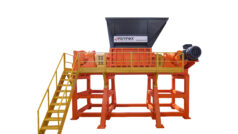The global market for composite products is expected to reach 86 billion euros globally by 2020. But as the study “Composites Recycling: Where are we now” by UK-based trade association Composites UK claims, the volume of end-of-life waste is still very small, due to the long life span of many products. However, a considerable amount of waste is being generated during the production process, between 30 and 50 per cent of the total amount produced. The study calculates that a total of 2,000 to 3,000 tonnes of carbon fibre reinforced polymer (CFRP) waste is generated in the UK per year.
A number of successful research projects have already been conducted in this field, but numerous obstacles still need to be overcome before these processes and products can be brought to
market. These include extensive tests, establishing new standards for products with recycled content, the volumes of material and the required investments for what are mostly low-margin products. Although the study sees a low level of interest from the industry itself, due to the current lack of economic pressure, there is a big difference between carbon fibre and glass fibre. While there is little interest in recycling low-value glass fibre, some large aerospace companies have supported carbon fibre recycling initiatives to recover this more valuable material. However, more applications are still needed since currently there is an oversupply in the market.
The study names four possible recovery processes to date: mechanical, thermal, chemical and co-use in cement kilns. In the mechanical process, the material is reduced in size and then ground and graded into different fractions. It can then be further separated by sieving into powders and fibres of various lengths. In some cases, the material is still partially embedded in resin and can contain other components as well. According to the study, ground composite can be used for two purposes – either as a filler or as a reinforcement. The powdered products can be used as fillers, but are not commercially viable, since virgin material is available at low cost. The incorporation of filler material is also limited to less than 10 per cent because of the deterioration in mechanical properties and the higher viscosity of the compound. The material is better suited as an energy source since it is rich in organic resin compounds. The mechanical process is not used commercially for CFRP, but only to destroy the material provenance prior to pyrolysis.
The different types of pyrolysis have proven to be far more successful. These processes typically operate between 400 and 600°C, depending on the resin and the atmosphere. During the process, the resin matrix is degraded thermally to form an oil, gasses and solid products (fibre, fillers, char). Usually, a small amount of oxygen is used to minimise the formation of char. This process enables the recovery of fibre, fillers and inserts. The resin is broken into lower-weight molecules (oil and gasses) that could be recovered as chemicals, but which are usually burnt. The mechanical properties of the fibre depend on the process conditions. The tensile strength of carbon fibres can be reduced by between 4 and 85 per cent, glass fibre by between 52 and 64 per cent. This reduction reflects the effect of the selected temperature. The study points out that 500 to 550°C has been established as the upper limit in order to maintain an acceptable fibre strength and is typically used in commercial processes.
Any thermal or chemical process reduces the size of the fibre. In the case of glass fibre, this results in a dramatic loss of strength and processability. For further use it has to be pre-heated, which makes no sense economically.
The chemical process of solvolysis uses a heated solvent mixture to break down the resin into chemicals of lower molecular weight. The carbon fibres are not dissolved and are released from the resin. Solvolysis is not suited for glass fibre, due to the degradation that occurs during the process. The wide range of solvents, temperatures, pressures and catalysts in this process opens up a great number of possibilities. Water is the most commonly used solvent. The use of catalysts can have some advantages. It can also influence the mechanical properties of the fibre.
Compared to pyrolysis, solvolysis requires lower temperatures and can lead to cleaner fibres. It also offers considerable potential to reclaim chemical value from the resin. On the other hand, the use of solvents and catalysts has a negative environmental impact. However, the mechanical properties are close to those of virgin material. At the present time, this process is mainly established at lab scale.
The fourth recovery process differs from the other three, as it does not include material recycling but the thermal use of the composites. Especially for glass fibre, experts recommend co-processing in cement kilns where the material is mixed with other types of solid recovered fuel. It is preferable to incineration in energy-from-waste facilities. The high calorific value of composite resin is not desirable in energy-from-waste. Moreover, the mineral content falls as ash, while otherwise it is recycled into the cement clinker.
The study points out that so far the focus has not been on the reuse of resin. The process is not straightforward and requires some additional steps. The fibrous fractions of ground thermoset materials can be used as reinforcement, which is the higher-value route compared to grinding to fine fill. This approach has not been developed beyond early research for carbon fibre, as the fibre value is high enough to justify thermal or chemical processes that result in cleaner fibres.
One of the main challenges of composites recycling is to find proper applications that can handle the various material properties. The study highlights some examples from textiles and preforms. Pieces of woven carbon fibre fabrics have been reclaimed from cured parts or prepreg scrap and reused with new resin. Retaining the fabric structure in this way may enable higher-value recycling of whole rolls of out-of-date prepreg. However, it is not easily scaled up for cured parts and offcuts, as variable shapes will be recovered which cannot be used directly, so a short fibre intermediate is needed.
Non-woven textiles have been manufactured from short recycled fibres by means of a wet papermaking process that involves dispersing fibres by blowing them with compressed air, by needle-punching and by carding to create slivers which are stitched into a partially aligned veil.
Recycled carbon fibres have also been incorporated into SMC and BMC, which are random discontinuous fibre materials with thermoset resin. The resulting materials were equivalent to compounds with virgin carbon fibres, showing only slightly decreased mechanical properties.
The environmental impact of composites recycling depends on the energy requirement, the study points out. For most recycling processes, electricity is the main source of power and dominates the energy footprint of the overall process. Reducing the amount of energy required is therefore key to improving sustainability. The different recycling processes vary in terms of energy requirement. However, the amount required is still 10 to 20 times lower than that needed to produce virgin glass or carbon fibres.
The study concludes that composites recycling is still in its infancy. The options currently available for recycling glass fibre in particular are still very few, but the high value of carbon fibre has resulted in a number of recycling companies commencing operations. However, the study concludes that recycling itself only solves part of the problem. It is also vital to find markets and applications that can viably utilise the recovered carbon fibre. Here, the key issue is that the recovered material is in a physical form unlike any virgin material, which limits the markets in which it can be sold. Carbon fibre volume fractions of up to 60 per cent are needed to make composites and near unidirectional fibre alignment is needed to achieve these fibre volume fractions. Another big challenge is the availability of material for recycling. Most of the products that include composites have a long life span, so the growth of recycling is likely to lag significantly behind the current growth in carbon fibre manufacturing.










